Fittingly for a company first founded in the Ottoman Empire, Epiphone guitars are made in factories all over the world. Although today, Epiphone is probably best known as the affordable foreign-manufactured Gibson, the brand has a long and storied history of its own.
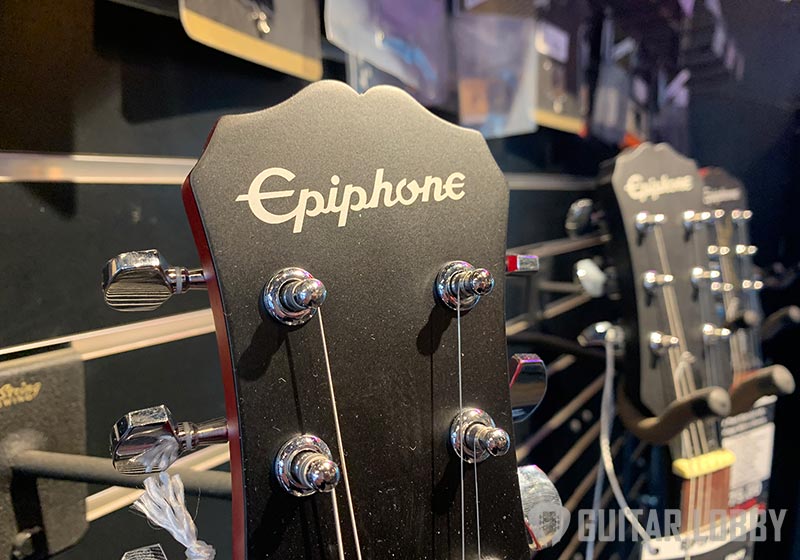
The Epiphone company’s origins lay in the late 19th century. A musical instrument builder by the name of Anastasios Stathopoulos opened a business in 1873 in Smyrna, deep in the Ottoman Empire. He moved to New York in 1903, taking his business with him, and when his son Epaminondas took over the business a few years later, he rechristened the fledgling company “Epiphone”, combining his own nickname “Epi” with the Greek word for “voice”, “phone”. While that’s all super interesting, many people wonder where Epiphone guitars are currently made.
Almost all Epiphone guitars are made in the Epiphone Qingdao factory in Qingdao, China, a major city in the Shandong province. This includes both the Inspired By Gibson line and Epiphone’s own original instruments.
More About the Epiphone Company
This Gibson-owned factory was, when it first opened, led by Gibson luthier Mike Voltz, overseeing the production of Epiphone’s core line of guitars. Initially, Epiphone mostly built guitars in China at a variety of non-Gibson-owned guitar factories such as Dongbei, Daewon, Muse, Mirr, Saejung, and Unsung-China. This initial run of Chinese Epiphone guitars was supplementary to the main factories in Korea and Japan, intended to provide additional manufacturing capacity for, particularly large orders. Gibson opened its own factory in Qingdao in 2002, producing mostly Epiphone acoustic guitars, but a dedicated Epiphone factory opened in 2006. It’s at this factory that most modern Epiphone instruments are built.
Check out this video for a tour of the Epiphone Factory in China:
Epiphone occasionally returned production to the USA throughout its history, usually for a limited run. Today, three Epiphone guitars are made in the USA, comprising the brand’s Made in USA Collection. Epiphone’s Made in USA Collection features three iconic Epiphone original instruments rather than Gibson copies. After all, those who want a USA-made Gibson guitar can simply buy a Gibson.
There are several distinct eras of Epiphone production, so determining the precise factory of origin since the Gibson takeover depends mostly on the guitar’s individual serial number and model. If you’re an Epiphone owner looking to determine the precise origin of your own guitar, we’ll look at Epiphone’s serial numbering system below.
Pre-Qingdao Epiphone guitars, as well as many made since can be reliably traced to their country of origin by their serial number.
Epiphone’s serial numbers can indicate origins in Korea, China, Japan, the Czech Republic, or Indonesia. Typically, the serial number on a modern Epiphone guitar (or at least since 1993) adopts the FYYMMRRRR format. This indicates:
F= Factory code
YY= year of manufacture, although 1990s models may only have a single digit.
MM= month of manufacture
R= ranking number
Example: S02021234 was issued in Feb. 2002 at the Korean Samick factory.
The factory codes F, J, and T indicate Japanese manufacture. A B factory code means the guitar is from the Czech Republic. CI and SI indicate Indonesian manufacture.
The various Korean factory codes are:
- F = Fine
- C = Korea
- I = Saein
- U = Unsung
- S = Samick
- P or R = Peerless
- K = Korea
The Chinese factory codes, including Qingdao, are:
- MR = CHINA
- DW = DaeWon
- EA = Gibson/QingDao
- EE = Gibson/QingDao
- MC = Muse
- SJ = SaeJung
- Z = Zaozhuang Saehan
- BW = China
For serial codes containing only numbers, an eleven digit serial number will be encoded as follows:
Example shown below: 20121308585
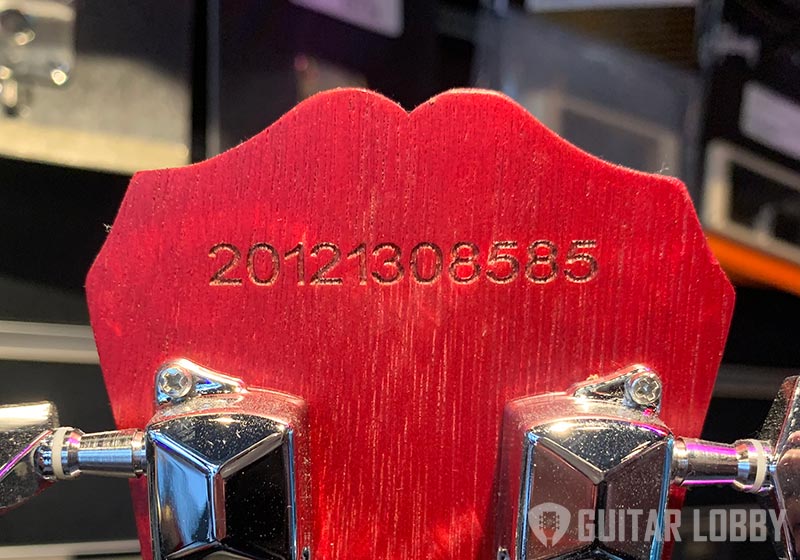
- The first two digits represent the last two digits of the production year – 20
- The fourth and fifth digits are the month of production – 12
- The fifth and sixth digits correspond to the factory code shown in the list below
- The last five digits are the series sequence number representing which number off the line your particular guitar was in its respective series.
So the example above most was manufactured in December 2020 in China and was the 8585th guitar off the line in the series.
Epiphone Numbered Factory Code List:
| CODE | FACTORY | COUNTRY |
| 10, 13, 17, 18 | Unknown | China |
| 12, 20 | DeaWon or Unsung | China or Korea |
| 15, 16 | Qingdao | China |
| 21 | Unsung | Korea |
| 22 | Unknown | Korea |
| 23 | Samick | Indonesia |
This broad array of factories is a testament to Epiphone’s global reach and Gibson’s wide-ranging efforts to produce affordable alternatives to its iconic guitars. Curiously, many Japanese Epiphones feature Gibson’s “open book” headstock rather than the “tombstone” headstock of most Epiphone instruments, as seen below. Of course, open-book headstock or no, Epiphone Japan’s guitars still boast the iconic Epiphone logo.
Who Makes Epiphone Guitars?
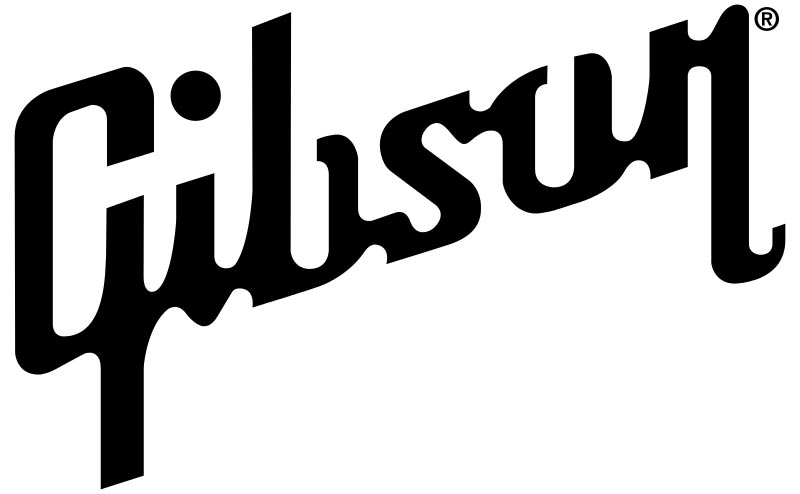
Epiphone guitars are owned and made by Gibson Brands. Generally speaking, for any Gibson guitar, there’s an Epiphone equivalent model. That applies to both the broad categories of Gibson guitars, such as Les Pauls, SGs, Explorers, Flying V, and so on, as well as signature instruments, such as the various Zakk Wylde signature guitars that once adorned the Gibson and Epiphone production lines.
At first, the Stathopoulos instrument company produced traditional instruments like the oud and banjo, but in 1928 upon seeing increasing demand for guitars in the US, Epi started building acoustic guitars. Epiphone remained a relatively unknown brand compared to American giants Gibson and Fender, until the 1960s when a little band from Liverpool called the Beatles proudly played Epiphone’s Casino model on television screens all over the world.
Epiphone’s high craftsmanship, particularly when it came to their hollow-bodied electrics, placed them in direct competition with the big boys of American guitar building. The Gibson guitar company acquired Epiphone in 1957, not long after the company had moved from New York to Philadelphia. Epiphone has remained a subsidiary of Gibson guitars ever since. However, that does not mean that Epiphone’s instruments are simply inferior Gibson copies. The Epiphone brand adorns a wide range of guitars, from low-end Gibson variations to their own unique models.
Generally speaking, Epiphone guitars can be comfortably divided into three price ranges. Their entry-level guitars, aimed at beginners. There are mid-range guitars, which tend to be lower-priced copies of Gibson’s flagship models such as the Les Paul and the SG. Finally, Epiphone also produces mid-range to high-end Epiphone exclusive guitars.
Epiphone guitars, generally speaking, are priced according to their country of origin. The brand’s factories have moved around significantly since the Gibson acquisition in 1957.
Epiphone guitars made since 1957 tend to fall in one of the below categories:
- USA-made Epiphone, which are usually the most expensive
- Japan-made Epiphone, which can rival USA-made guitars for quality and price
- Korean-made Epiphone, cheaper than the US or Japan
- Chinese-made Epiphone, typically the cheapest available models
Epiphone’s manufacturing moved to Asia in the 1980s, but occasional runs of premium Epiphone guitars have been made in the US since. Epiphone introduced the Made in USA collection in 2021, which features three of Epiphone’s original designs, built by master luthiers in Kalamazoo, Michigan.
Curiously, when it comes to Epiphone’s guitars, their price and country of origin aren’t necessarily indicators of quality. Many Japanese and Korean Epiphone guitars rival their American cousins for build quality. In fact, some high-end Epiphone guitars are even better than the lower-tier Gibsons!
Difference Between Gibson and Epiphone
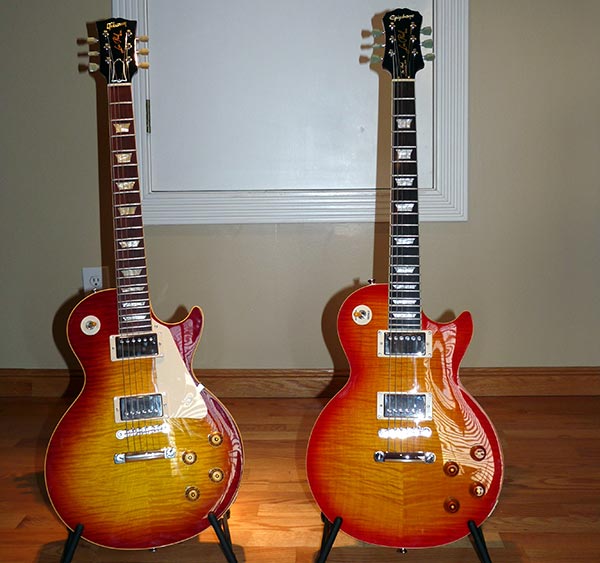
Most of Epiphone’s guitars today are mid-priced imitations of Gibson’s premium options, which come with a premium price tag. Take for example the Gibson Les Paul Custom, which was introduced in 1953. The Les Paul Custom, when it was first brought to market, epitomized Gibson’s masterful craftsmanship. The Custom was a beautiful instrument, adorned with the highest-quality materials, and built with (at the time) cutting-edge technology like a stop tailpiece and Gibson’s now-famous dual humbuckers. It was intended to be the luxury alternative to the standard Les Paul (not to be confused with the Les Paul Standard, introduced later that decade) that hit the market in 1952.
A vintage Les Paul Custom will set you back about $40,000.000, depending on the condition of the guitar and if anyone famous played it. If spending a year’s salary on an old guitar doesn’t appeal to you, you’re not alone. You can buy a Les Paul Custom from the much-maligned “Norlin era” of the 1970s for under ten thousand if you don’t mind a Les Paul with a maple neck and multi-piece body.
A modern Gibson Les Paul Custom costs just under $5000. While that’s significantly less than an original model from the 1950s, this exorbitant price tag puts the Les Paul Custom out of the reach of most working musicians. Gibson may even prefer to save some instruments only for their most well-heeled customers as they might lose some allure if anyone could play a Les Paul Custom.
However, for those willing to acquiesce to a few cost-saving measures, such as the location of the factory, quality of wood, and the name on the headstock, an affordable alternative to the Les Paul Custom is available.
The Epiphone Les Paul Custom comes with many similar, if slightly cheaper, appointments to the Gibson Les Paul Custom, all with a price tag under a thousand dollars. For guitarists looking for an affordable alternative to a true Gibson, these Gibson-endorsed inexpensive copies are a great option.
What could account for such a hefty difference in price?
For a start, every inch of the Gibson Les Paul Custom is premium, while the Epiphone features cost-saving measures. A Gibson Les Paul will be made from solid mahogany, while the Epiphone equivalent will be made from a few pieces of wood glued together in a Les Paul shape. The same goes for the neck of the guitar and its fretboard, although purists will be pleased to learn that modern Epiphone Les Paul Custom guitars feature an ebony fretboard just like the real thing, albeit not a single piece of ebony.
The Gibson Les Paul Custom also boasts Gibson pickups, which are of higher quality than the Epiphone ProBuckers of the Epiphone Les Paul Custom. Likewise, the Gibson model’s fret inlays are mother of pearl, while Epiphone’s are pearloid. Similarly, the potentiometers and pickup selector on the Gibson model are of higher quality and will be more durable than those in the Epiphone Les Paul. The Gibson Les Paul comes with 2 500K CTS Volume Pots, 2 500K CTS Tone Pots, Hand-Wired Harness, and a premium Switchcraft Toggle Switch, while the Epiphone merely uses its own stock parts.
The other major cost-saving measure of Epiphone’s Gibson-like guitars is where they’re built. For much of the 21st century, Epiphone’s guitars were made in a Gibson-owned factory in Qingdao, China, where the overheads related to guitar construction are far cheaper than those in the USA.
USA Built Epiphone Guitars vs China Built Epiphone Guitars
There are three US-made Epiphone guitars in 2021. These are:
| Epiphone Casino | USA Collection |
| Epiphone Texan | USA Collection |
| Epiphone Frontier | USA Collection |
To somewhat confuse matters, these three guitars also have Chinese-built Epiphone equivalents on the market. Unless otherwise indicated, it’s safe to assume that all Epiphone Casinos, Texans, and Frontiers are made in China. There are several key differences between the Chinese Epiphone guitars and their American cousins, most notably in pricing.
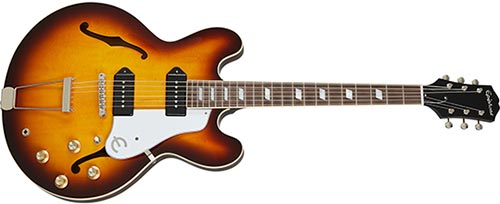
Epiphone’s US-built Casino, priced at $2,699.00, is a far more expensive instrument than the Qingdao Casino, which costs $649.00.Like the earlier comparison between Gibson and Epiphone guitars, this has as much to do with location-based overheads as with materials and construction.
The US-made Casino features a solid mahogany neck, while the Chinese Casino’s neck is simply listed as “mahogany”, indicating that it is made from multiple pieces of wood rather than a single block. The USA Casino’s body is made from a 3-ply maple-and-poplar “sandwich”, with two blocks of maple separated by a block of poplar. This is an accurate reproduction of the original Casino’s construction, as played by John Lennon, Keith Richards, and Paul Weller. The Chinese Casino’s body is laminated maple, a cheaper alternative.
Similarly, the American Casino’s fretboard is prized Indian rosewood with acrylic fret inlays, compared to the Chinese Casino, which has a pau ferro fretboard and pearloid inlays.
The USA Casino also uses Gibson USA P90 pickups, compared with the $649 Casino’s Epiphone Dogear P-90T Classic. Similarly, the USA Casino’s electronics are of higher quality than in the Chinese version, with hand-wired controls and Orange Drop capacitors as opposed to the stock Epiphone controls and capacitors in the Chinese Casino.
The USA Casino’s hardware is similarly superior to that of its Chinese cousin. Its nickel ABR-1 bridge offers a more vintage-looking (and sounding) alternative to the Chinese Casino and its LockTone™ Tune-O-Matic bridge.
Likewise, two of Epiphone’s iconic acoustic models boast USA-made and Chinese-made variations.
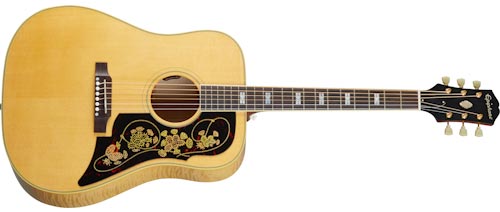
The Epiphone Frontier from the USA collection commands a whopping price tag of $3,999.00, five times the price of the Chinese-made Masterbilt Frontier at $799.00. Like the Casino, there are several key differences between these two to justify the vast gulf in pricing.
The Made in USA Frontier is made in Bozeman, Montana, in tribute to the original Epiphone Frontier made from 1958 to 1970. The guitar has high-end materials to suit its high price tag, including a solid Sitka spruce top and solid figured maple back and sides, Indian rosewood fretboard, traditional hand-scalloped X-bracing, and gold-plated Gotoh Keystone tuners. The Epiphone equivalent, impressively, features similar construction, including the same materials for the guitar’s top, back, and sides. Even the “lariat-and-cactus” pickguard, as seen in the image above, is common to both instruments. The primary difference in the guitar’s construction is it’s bracing, as the Chinese-made Frontier lacks the hand-scalloped X-bracing of its American cousin. The Masterbilt Frontier also uses Indian laurel, rather than rosewood, for its fretboard material, which has lighter color.
The American Epiphone Frontier also comes with an LR Baggs VTC pickup, which is worth around $200 on its own. The Chinese-made Masterbilt Frontier uses a Fishman Sonicore pickup instead.
Epiphone saved on materials for the Frontier primarily on its aesthetic appointments. Both guitars share a rectangle inlay in the neck, although the Made in USA Epiphone Frontier has mother-of-pearl split rectangle inlays compared to the Masterbilt’s pearloid. Similarly, the US-made Frontier has a genuine bone nut, as opposed to its Chinese cousin’s imitation NuBone nut. These material differences are mostly aesthetic and probably won’t affect the guitar’s playability or tone.
The main difference in price seems to be the Epiphone Frontier’s country of manufacture and the level of expertise involved in its creation. According to Epiphone’s website, the US-made Frontier was handcrafted in the USA by “Gibson’s finest acoustic luthiers”, while the Chinese-made Masterbilt is a production line guitar built en masse in Qingdao. The US-made Frontier also comes in a natural aged finish, while the Chinese Frontier only comes in the “Iced Tea Aged Gloss” finish.
The Epiphone Texan is a lower-priced guitar than the Frontier, aimed squarely at working musicians. Some of popular music’s finest songwriters used the Epiphone Texan, including Paul McCartney, Peter Frampton, and Oasis axeman Noel Gallagher. First introduced in 1958, today the Texan is made in Epiphone’s Bozeman facility or in China. Like the Frontier, the US-made Texan commands a far higher price than its Chinese cousin. Again, like the Frontier, much of this price difference is rooted in the location of the guitar’s building, its aesthetic appointments, and the expertise of Gibson’s master luthiers involved in its construction.
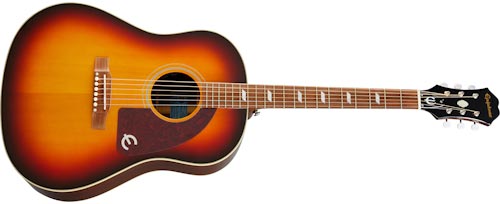
The Made in USA Epiphone Texan retails for around $2,699.00, while the Epiphone Masterbilt Texan goes for less than half that at $699.00.
The materials used to make these guitars are near-identical. They both feature the solid sitka spruce top of many high-end acoustics, as well as solid mahogany back and sides. Both guitars feature a mahogany neck, which provides warmth and depth to the instrument’s tone. Where their construction differs is that the US-made Epiphone Texan features Traditional hand-scalloped X bracing, which the Chinese-made Texan lacks. This labor-intensive bracing is far more expensive than simply producing factory guitars, and was how many high-end acoustic guitars were made decades ago. Both guitars share the same dovetail neck joint.
The US-made Texan’s fretboard is Indian rosewood, while its Chinese cousin has a fretboard of Indian laurel. Again, like the Frontier, the US model uses a genuine bone nut while the Chinese Texan has a Graph Tech NuBone nut. Similarly, the American model uses mother-of-pearl for its fret and headstock inlays while the Chinese have cheaper pearloid. Again, as with the American-made Epiphone Frontier, the Made in USA Texan uses an LR Baggs VTC pickup, while the Masterbilt has a cheaper Fishman Sonitone.
The differences between the American-made and Chinese-made Epiphone guitars are relatively minor, despite calling two very different continents home. This is a testament to Epiphone’s remarkable quality control, as the brand continues to produce quality instruments at competitive prices.
Signature Epiphone Guitars
No article about the home of Epiphone guitars would be complete without reference to Epiphone’s line of artist signature guitars. Although many of Epiphone’s instruments are Gibson imitations, Epiphone also produces unique instruments of higher quality than many of its standard offerings. Generally, artist signature Epiphone guitars, although they are made in China, come with upgraded features that set them apart from their factory standard brethren.
For example, Slash’s signature line of Epiphone Les Pauls comes with Gibson Custom Burstbuckers, designed specifically for the top-hatted one himself. In fact, the Slash line of Epiphone Les Pauls bears a greater resemblance to Gibson’s ordinary Les Pauls than Epiphone’s, with CTS potentiometers with Orange Drop capacitors and a AAA flamed maple top.
Other Epiphone signature guitars include Jared James Nichols’ unique single-pickup Les Paul Custom, which comes with a Seymour Duncan pickup, Grover Rotomatic tuners, and even a genuine ebony fretboard. If it wasn’t for the brand name on the headstock, such an instrument could easily be mistaken for a Gibson guitar.
Even the mighty KISS, one of the biggest rock bands in the world, isn’t immune to the charms of an Epiphone guitar, with the band’s lead guitarist Tommy Thayer brandishing one of his own signature Les Pauls. These also feature Seymour Duncan JB pickups and Grover tuners.
There’s even an Epiphone Les Paul with a Floyd Rose locking tremolo!
Although, for a long time, Chinese manufacture was synonymous with poorer quality control, modern Epiphone guitars made in Qingdao often rival their Gibson counterparts at a far lower price point.
Wrap Up
That does it for this article, if you have any questions at all at this point about where Epiphone guitars are made just let us know in the comments below.

My name is Chris and I’ve had a passion for music and guitars for as long as I can remember. I started this website with some of my friends who are musicians, music teachers, gear heads, and music enthusiasts so we could provide high-quality guitar and music-related content.
I’ve been playing guitar since I was 13 years old and am an avid collector. Amps, pedals, guitars, bass, drums, microphones, studio, and recording gear, I love it all.
I was born and raised in Western Pennsylvania. My background is in Electrical Engineering, earning a Bachelor’s degree from Youngstown State University. With my engineering experience, I’ve developed as a designer of guitar amplifiers and effects. A true passion of mine, I’ve designed, built, and repaired a wide range of guitar amps and electronics. Here at the Guitar Lobby, our aim is to share our passion for Music and gear with the rest of the music community.

I am trying to decode the ss# on my EIEPHONE collection
But have so many it is HARED to do the decoding you hff ave in your article like were ,were
The Nancy WILSON guitars
Built and the Electric Blue Tommy THAYER were was it built waited a year to get one and I have CARING 250 more so I can catalog my collection thanks
Tracy Rhoads
rhoadstorhodes@gmail.com
as in late great
Randy Rhoads
Great article, well done!